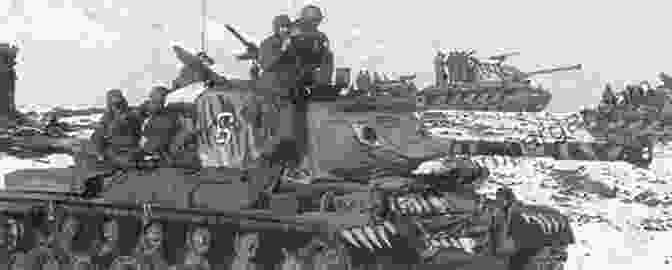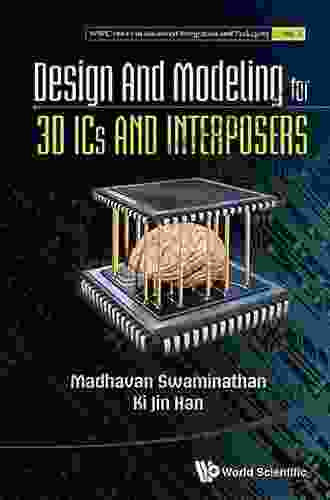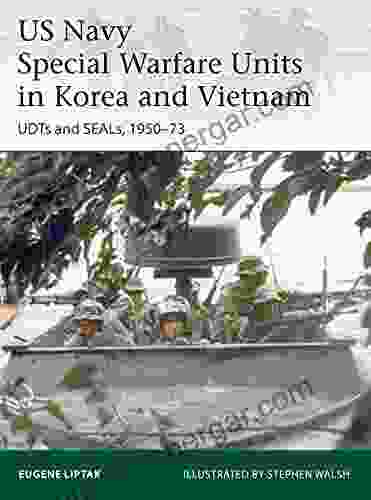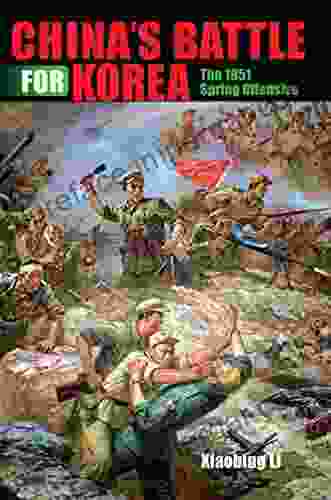China's Battle for Korea: The 1951 Spring Offensive

4.2 out of 5
| Language | : | English |
| File size | : | 7970 KB |
| Text-to-Speech | : | Enabled |
| Screen Reader | : | Supported |
| Enhanced typesetting | : | Enabled |
| Print length | : | 418 pages |
| Lending | : | Enabled |

The Korean War, a bloody and protracted conflict that raged from 1950 to 1953, marked a pivotal moment in global history. Amidst the fierce battles and political turmoil, the Chinese Spring Offensive of 1951 emerged as a turning point, shifting the war's dynamics and leaving an enduring legacy on international relations.
This article delves into the intricacies of the Chinese Spring Offensive, providing a comprehensive examination of its historical context, strategic significance, and the firsthand experiences of soldiers who fought on the front lines. Through rare photographs, detailed maps, and expert analysis, we will unravel the motivations, tactics, and consequences of this pivotal campaign that reshaped the course of the Korean War.
Historical Context
The Korean War erupted in June 1950 when North Korea invaded its southern neighbor, triggering a swift response from the United States and its allies. As the conflict escalated, China, fearing the potential threat to its bFree Download, entered the war in October 1950, sending hundreds of thousands of troops to support North Korea.
By the spring of 1951, the war had reached a stalemate, with neither side able to make significant progress. However, the Chinese leadership, fueled by a desire to expel UN forces from the Korean Peninsula and secure its northern bFree Download, devised a plan for a major offensive.
Strategic Objectives
The Chinese Spring Offensive, codenamed Operation Thunderbolt, aimed to achieve several strategic objectives:
- Drive UN forces out of North Korea and establish a buffer zone along the Yalu River.
- Weaken the morale of UN troops and demonstrate China's military might.
- Compel the United States to negotiate a peace settlement on China's terms.
Chinese Preparations
In the months leading up to the offensive, the Chinese amassed a formidable force of over 700,000 troops, supported by artillery, tanks, and aircraft. They meticulously planned their attack, studying UN troop positions, terrain, and logistical challenges.
The Chinese also employed deception tactics, misleading UN intelligence about their true intentions. They dispersed their forces, concealed their troop movements, and spread rumors of an impending offensive in other sectors of the front.
UN Responses
Despite Chinese efforts to maintain secrecy, UN intelligence detected signs of an impending offensive. General Douglas MacArthur, the UN commander, Free Downloaded his forces to prepare for a major attack, but he underestimated the scale and intensity of the Chinese offensive.
UN troops, consisting of a multinational force led by the United States, were deployed along a defensive line stretching across the Korean Peninsula. They relied on their superior firepower and air support, but they were outnumbered by the Chinese.
The Offensive Begins
On April 22, 1951, the Chinese Spring Offensive commenced with a massive artillery barrage followed by waves of infantry attacks. The Chinese forces, employing human wave tactics, overwhelmed UN positions and pushed them back.
The fighting was fierce and bloody. UN troops, caught off guard by the ferocity of the Chinese offensive, struggled to hold their ground. The Chinese advanced rapidly, capturing key terrain and threatening to cut off UN supply lines.
UN Counteroffensive
As the Chinese offensive gained momentum, General MacArthur launched a counteroffensive, dubbed Operation Killer, in May 1951. UN forces, bolstered by reinforcements and air support, pushed back against the Chinese advance.
The fighting raged for weeks, with both sides suffering heavy casualties. The UN forces gradually regained some lost ground, but they failed to halt the Chinese advance completely.
Stalemate and Negotiations
By July 1951, the Chinese Spring Offensive had reached a stalemate. The Chinese had achieved some of their objectives, but they had also suffered significant losses. UN forces, though pushed back, had prevented the Chinese from achieving a decisive victory.
With both sides exhausted and facing mounting casualties, negotiations for a ceasefire began in July 1951. After two years of bitter fighting, an armistice was finally signed on July 27, 1953, ending the Korean War.
Legacy of the Offensive
The Chinese Spring Offensive of 1951 had a profound impact on the Korean War and its aftermath:
- It demonstrated the military prowess of the Chinese army and its determination to defend its interests.
- It shifted the balance of power in the war, forcing the United States and its allies to reassess their strategy.
- It contributed to the stalemate that ultimately led to the ceasefire and the division of Korea into two separate countries.
- It heightened tensions between the United States and China, setting the stage for decades of Cold War rivalry.
The Chinese Spring Offensive of 1951 was a pivotal moment in the Korean War, reshaping its course and leaving a lasting legacy on international relations. It showcased the resilience of the Chinese military, the determination of both sides to fight for their objectives, and the complexities of a war that drew in multiple nations and ideologies.
By delving into the historical context, strategic significance, and firsthand accounts of this epic campaign, we gain a deeper understanding of the Korean War and its enduring impact on the world.
4.2 out of 5
| Language | : | English |
| File size | : | 7970 KB |
| Text-to-Speech | : | Enabled |
| Screen Reader | : | Supported |
| Enhanced typesetting | : | Enabled |
| Print length | : | 418 pages |
| Lending | : | Enabled |
Do you want to contribute by writing guest posts on this blog?
Please contact us and send us a resume of previous articles that you have written.
 Book
Book Novel
Novel Page
Page Chapter
Chapter Text
Text Story
Story Genre
Genre Reader
Reader Library
Library Paperback
Paperback E-book
E-book Magazine
Magazine Newspaper
Newspaper Paragraph
Paragraph Sentence
Sentence Bookmark
Bookmark Shelf
Shelf Glossary
Glossary Bibliography
Bibliography Foreword
Foreword Preface
Preface Synopsis
Synopsis Annotation
Annotation Footnote
Footnote Manuscript
Manuscript Scroll
Scroll Codex
Codex Tome
Tome Bestseller
Bestseller Classics
Classics Library card
Library card Narrative
Narrative Biography
Biography Autobiography
Autobiography Memoir
Memoir Reference
Reference Encyclopedia
Encyclopedia Roy Shepard
Roy Shepard Eddie Alfaro
Eddie Alfaro Doug Sahlin
Doug Sahlin Ben Buchanan
Ben Buchanan Les Brown
Les Brown Endall Beall
Endall Beall Ray L Birdwhistell
Ray L Birdwhistell Nicola Lucchi
Nicola Lucchi Dr Karen Hills Pruden
Dr Karen Hills Pruden Dr Harshavardhan Patwal
Dr Harshavardhan Patwal Jonathan Sacks
Jonathan Sacks Eevi Jones
Eevi Jones Doreen Hanna
Doreen Hanna Rachel Fehily
Rachel Fehily Dylan Howard
Dylan Howard Douglas L Wilson
Douglas L Wilson Javier De Alva Garza
Javier De Alva Garza Donald E Graves
Donald E Graves Dominique Kaneza
Dominique Kaneza Douglas R Egerton
Douglas R Egerton
Light bulbAdvertise smarter! Our strategic ad space ensures maximum exposure. Reserve your spot today!

 J.R.R. TolkienUnveiling the Revolutionary Design and Modeling for 3D ICs and Interposers: A...
J.R.R. TolkienUnveiling the Revolutionary Design and Modeling for 3D ICs and Interposers: A...
 Hayden MitchellThe Modern Challenge: A Comprehensive Guide to Navigating the Complexities of...
Hayden MitchellThe Modern Challenge: A Comprehensive Guide to Navigating the Complexities of...
 Chandler WardScotland, the Caribbean, and the Atlantic World, 1750-1820: Unraveling the...
Chandler WardScotland, the Caribbean, and the Atlantic World, 1750-1820: Unraveling the... Raymond ParkerFollow ·16.4k
Raymond ParkerFollow ·16.4k Dean CoxFollow ·3.8k
Dean CoxFollow ·3.8k Cody RussellFollow ·2.5k
Cody RussellFollow ·2.5k Pat MitchellFollow ·2.2k
Pat MitchellFollow ·2.2k Kirk HayesFollow ·10.6k
Kirk HayesFollow ·10.6k Camden MitchellFollow ·10.7k
Camden MitchellFollow ·10.7k Tony CarterFollow ·4.5k
Tony CarterFollow ·4.5k Lawrence BellFollow ·4.8k
Lawrence BellFollow ·4.8k

 Donovan Carter
Donovan CarterUnveiling the Tapestry of Western Civilization:...
: Step into the annals of Western...

 Pablo Neruda
Pablo NerudaUnveil the Secrets: The Welsh Murder Mysteries
Prepare to be captivated as...

 Benji Powell
Benji PowellNot Without Our Consent: Lakota Resistance to...
In the mid-20th...

 Ryan Foster
Ryan FosterUncover the Heroic Exploits of U.S. Navy Special Warfare...
The annals of modern warfare are replete...

 Gage Hayes
Gage HayesPlan to Provide Quality Care for All While Saving...
The healthcare...

 Felix Carter
Felix CarterUnveiling the Timeless Wisdom of Machiavelli: The...
Niccolò...
4.2 out of 5
| Language | : | English |
| File size | : | 7970 KB |
| Text-to-Speech | : | Enabled |
| Screen Reader | : | Supported |
| Enhanced typesetting | : | Enabled |
| Print length | : | 418 pages |
| Lending | : | Enabled |






